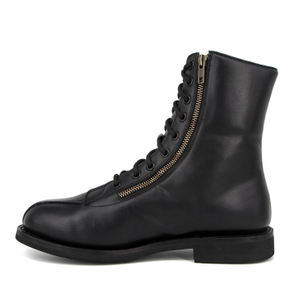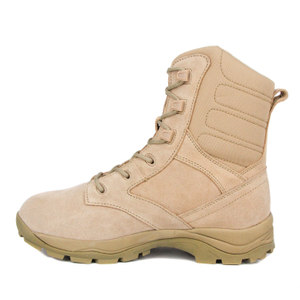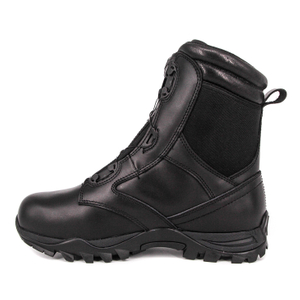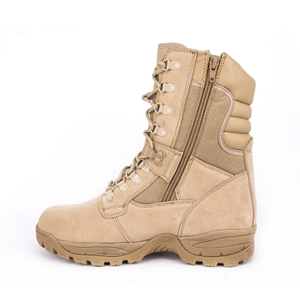When it comes to military footwear, choosing the right pair of boots can be a critical decision. Military boots are designed to provide protection, comfort, and support during intense physical activity, rough terrain, and various environmental conditions. With so many types of military boots available—each tailored to specific needs and regulations—picking the right one requires careful consideration. This guide will take you through the key aspects to consider when selecting military boots, from regulations to materials and features.
1. Understand the Requirements for Your Military Branch
Each branch of the U.S. military has specific regulations that dictate the types of boots its personnel can wear. These regulations ensure that boots meet the required standards for durability, functionality, and safety. Understanding the requirements of your military branch is the first step in choosing the right pair of boots.
Army Boots
The Army has adopted coyote brown boots as part of the new OCP uniform. Soldiers are required to wear boots that are at least 8 inches tall with a soft toe.
Air Force Boots
Similar to the Army, the Air Force has also adopted coyote brown boots. The key difference is that Air Force personnel are allowed to choose between soft toe or safety toe boots.
Coast Guard Boots
Color: Black
Height: 8" - 10"
Toe Type: Composite toe
Regulation: M1020.6J
Coast Guard personnel must wear black boots that are between 8 and 10 inches tall, with a composite toe for protection against heavy equipment.
USMC Boots
Color: Olive mojave or coyote brown
Height: 8 inches
Toe Type: Soft or steel toe
Material: Flesh-out cattlehide leather
Regulation: MCO 1020.34H
Marines have strict guidelines about their boots, including color, height, and toe type. The USMC also mandates the Eagle, Globe, and Anchor insignia on the boots.
Navy Boots
Color: Black
Height: 8" - 9"
Toe Type: Steel toe
Material: Smooth Leather
Regulation: 15665I
The Navy requires steel-toe boots with a black color for protection. Sailors may also opt for boots with Vibram outsoles and GORE-TEX linings for added water resistance.
Space Force Boots
The newly formed U.S. Space Force has adopted the same uniform and boot regulations as the Army, requiring 8-inch coyote brown boots with a soft toe.
2. Key Features of Military Boots
Once you've understood the basic regulations for your branch, it's time to consider additional features that enhance the performance and comfort of your boots. Military boots are designed for specific environments and tasks, so choosing the right features is crucial.
Composite Toe Military Boots
Composite toe boots are lighter than steel toe boots, offering protective features without the added weight. These are ideal for personnel who require a protective boot but want to avoid the bulkiness of steel toe boots. These are common in the Air Force and Coast Guard.
Soft Toe Military Boots
Soft toe boots are lightweight and offer great comfort for extended wear. They are ideal for personnel who do not need additional toe protection and prefer a more flexible and breathable boot. The Army and Space Force typically wear these boots.
Steel Toe Military Boots
Steel toe boots provide heavy-duty protection for personnel working in environments where heavy equipment or potential hazards are present. The Navy requires steel toe boots, and Marines may opt for them based on personal preference. Steel toes are essential in ensuring safety in high-risk environments.
Hot Weather Military Boots
Hot weather boots are designed for arid, desert-like conditions. These boots are lightweight, breathable, and equipped with drain holes to keep sand out and air circulating. Soldiers operating in warmer climates, such as the Middle East, will find these boots essential.
Jungle Military Boots
Jungle boots are perfect for humid, wet, and muddy environments, like those found in tropical regions. These boots have wide lugs for mud traction and drain holes that allow water to flow out, ensuring your feet stay dry and comfortable.
Lightweight Military Boots
Lightweight boots weigh less than 25 ounces per boot, making them ideal for reducing fatigue during long operations. The U.S. Army's research has shown that lighter boots significantly reduce foot fatigue and improve performance.
Insulated Military Boots
For personnel who will be operating in extremely cold environments, insulated military boots are a must. These boots often feature Thinsulate or similar synthetic fibers that block cold air while keeping feet dry and comfortable in frigid temperatures.
Waterproof Military Boots
Waterproof boots are designed to keep your feet dry by preventing external water from entering the boots. GORE-TEX is a popular membrane that ensures breathability while keeping your feet protected from rain and snow.
Side-zip Military Boots
Side-zip boots offer easy and quick access, making them perfect for soldiers who need to get in and out of their boots rapidly. The Air Force often allows these boots for their convenience and efficiency.
3. Military Boot Components
Military boots consist of several key components: the upper, midsole, and outsole. Each part plays an important role in the boot's overall performance, so understanding these components will help you make an informed decision.
Military Boot Upper
The upper portion of the boot surrounds your foot and sometimes extends above your ankle. Common materials used for the upper include:
Flesh-out leather: This leather is highly durable, making it a popular choice for military boots.
Suede: Softer and more flexible, suede is often used for lightweight boots.
Genuine leather: Though it may not be the most durable, genuine leather is still a common material used for affordable boots.
Synthetic leather: This man-made material is a more affordable option but lacks the durability of natural leather.
Cordura: Known for its durability, Cordura is resistant to scuffs and tearing, ideal for tough military conditions.
Military Boot Midsole
The midsole is located directly beneath the removable insole and provides comfort and support. Common midsole materials include:
Ethylene Vinyl Acetate (EVA): EVA is a lightweight and comfortable material that provides cushioning for long periods of use.
Polyurethane (PU): PU is denser than EVA and provides more long-lasting durability.
Shanks: Steel shanks offer protection against sharp objects on the ground and provide balance when carrying heavy loads.
Military Boot Outsole
The outsole of the boot is in direct contact with the ground and provides traction, protection, and comfort. Common outsole materials include:
Rubber: Vibram rubber outsoles are known for their flexibility and excellent traction, ideal for various terrains.
Polyurethane (PU): PU outsoles are durable and waterproof, providing added protection underfoot.
Lug patterns: Deep grooves designed for excellent grip and traction, especially on slippery or uneven surfaces.
Conclusion
Choosing the right military boots is crucial for ensuring comfort, protection, and performance. With so many options available, it's essential to consider branch requirements, boot features, materials, and fit. Properly selected boots will enhance your ability to handle any mission, whether in extreme conditions or during everyday tasks. Milforce Equipment Co., Ltd. offers a wide range of high-quality military boots designed to meet the demands of military personnel. Their boots provide durability, comfort, and safety, making them an excellent choice for soldiers.






















